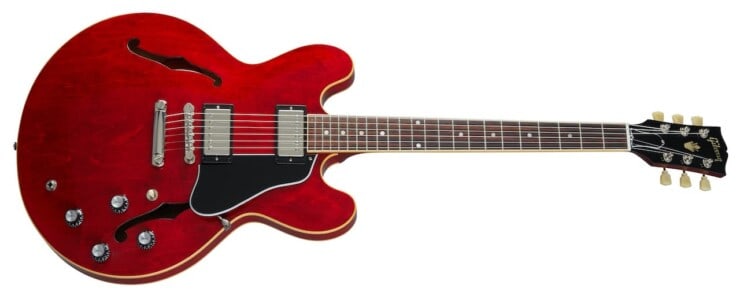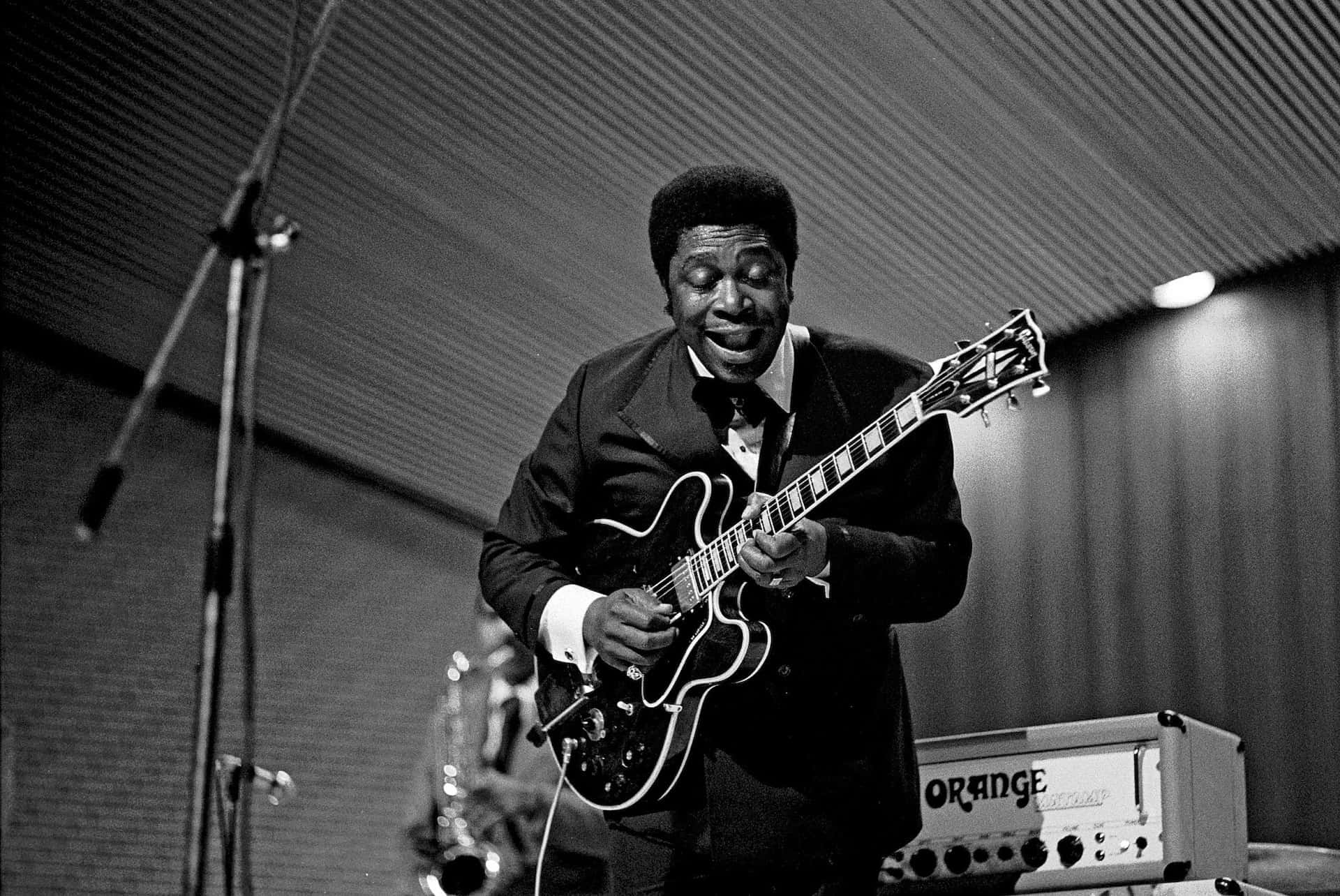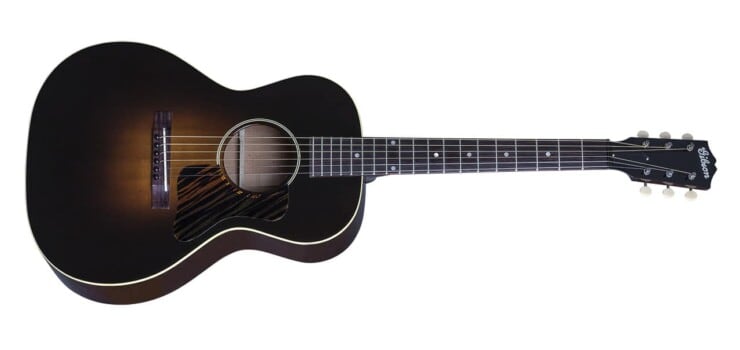It was 1949 in a flaring Arkansas dance hall when young legendary bluesman B.B. King learned that the fight that started the fire was over a woman named Lucille. Ever since that day, the king of blues started using the name “Lucille” for all his guitars, from Gibsons to Fender Telecasters.
It’s important to keep in mind that Lucille isn’t a single guitar, which is a common misconception that stems from the fact that Gibson released a special edition of B.B. King’s most famed guitar, the ES-355, back in 1980, and has given it the official brand name “Lucille” in honor of King.
Gibson guitars were King’s main preference, but he used a bunch of other guitars from different brands over the course of his illustrious and inspiring career. In this article, we’ll briefly cover all you need to know about B.B King’s most memorable guitars, so stick around for a little while.
ALSO READ: Guitar Lessons By Guitar Tricks – Are They Really Good?
Gibson ES-335
What better way to kickstart this article than to discuss King’s most iconic guitar, the ES-335. It’s the very first semi-hollow guitar to ever bless the market, which makes it one of the most central innovations in the world of hollow-bodied electric guitars. It’s the epitome of the blues sound.

The thing about hollow-bodied guitars, however, is that they produce a notable deal of feedback if played at high volumes. To reduce the amount of feedback produced by the guitar, Gibson put a maple strip through the ES-355, which helped open the door to high-volume experimenting.
The ES-335’s rich sound is a result of combining a layer of maple with a layer of poplar. Being a semi-hollow guitar, Gibsons’s ES-335 doesn’t suffer from any of the feedback issues associated with hollow-bodied guitars. The guitar’s deep sound has made it a perfect choice for soloists.
RELATED: What kind of guitar does James Taylor play?
Like the vast majority of electric guitars from its era, the ES-355’s neck is fairly thick, allowing for trouble-free sweeping and bending, which is another reason why it’s a soloist’s guitar. Its neck is built from pure mahogany, adding a slightly darker timbre to the sound with a bit of sustain.
The Gibson ES-335’s bridge-neck configuration flaunted a couple of humbucker pickups that the guitarist can choose from. Unbalanced pickups were actually fairly common back then and were the reason why guitars from the ES-355’s era had a more distinct sound than today’s guitars.
Gibson Lucille
As stated in the introduction, Gibson created a special version of the ES-335 in 1980 and called it the Gibson Lucille in honor of B.B. King. The difference between the ES-335 and the Lucille is that the latter didn’t feature any F-holes, which helped reduce the feedback even more.
The above-mentioned modification to the ES-335 was at the request of King himself because he used to fill the F-holes with pieces of cloth in order to reduce feedback. The Lucille also featured 490 Alnico humbucker pickups. The Gibson Lucille is available in a wide variety of colors.
Gibson L-30
The Gibson L-30 was B.B. King’s very first guitar. It’s actually the one he was playing before the fight broke out in the Arkansas dance hall we’ve talked about. He managed to save his $30 L-30 and started calling it Lucille ever since that day, as the fight was over a woman named Lucille.
The Gibson L-30 was designed as a starter guitar, hence its notably low price. The guitar had a pretty small body and was made out of mahogany. It wasn’t very easy to play because it didn’t have a cutaway. The Gibson L-30 is no longer in production, as the line was suspended in 1943.
Fender Telecaster
If you listen to any of King’s recordings with RPM records, you’ll hear a different sound from the one produced by the ES-335. This is because B.B. King utilized a different instrument for these recordings, and that’s the Fender Telecaster, which is the first successful solid-body electric.
The production of the Fender Telecaster started in the 50s, and to this day, it remains one of the most popular electric guitars on the market today. The Fender Telecaster is created from porous wood. Ash, to be specific. This choice of material is the reason behind its bright yet rich sound.
Gibson ES-125
Yet another Gibson! If you’re a B.B. King fan, you probably remember his cover of “Three O’Clock Blues” by Lowell Fulton, which had quite a massive impact on King’s music career, as it was his first major break. The guitar that B.B. King used to record that cover was the Gibson ES-125.
Unlike other guitars that King used, the ES-125 has a light timbre, but it offered the right amount of brightness King needed to do his 12-bar solos. Construction-wise, the guitar was made out of layered poplar and maple. Unlike many of King’s other guitars, the ES-125 was entirely hollow.
RELATED: What guitar does Taylor Swift play?
The ES-125’s hollow construction resulted in significant feedback, which made it unsuitable for playing at high volumes. Regardless, B.B. King used the ES-125 anyway and made a fantastic cover using it. Sadly, the production of the Gibson ES-125 was discontinued in the 1970s.
Final Thoughts
Hopefully, the information provided in this article has given you some insight regarding some of B.B. King’s most notable guitars. Want to learn how to play the guitar like the king of blues? We recommend checking out the Guitar Tricks online program – they offer excellent guitar lessons.
Frequently Asked Questions
What Happened to B.B. King’s Guitar?
In 2005, Gibson presented King with a prototype of the ES-345 on his 80th birthday. The guitar was actually the first in a very limited edition of 80 guitars. The guitar was stolen in 2009 and it was traded in a pawn shop in Las Vegas. It was later returned to King after some investigations.
How Much is B.B. King’s Guitar Worth?
The Gibson ES-345 prototype, which was one of King’s most beloved guitars, was sold at a US auction for $280,000. It’s the same guitar that was stolen and traded in a pawn shop in 2009.
Image Credits:
Featured Image: Heinrich Klaffs, CC BY-SA 2.0, via Wikimedia Commons
Images: Gibson






